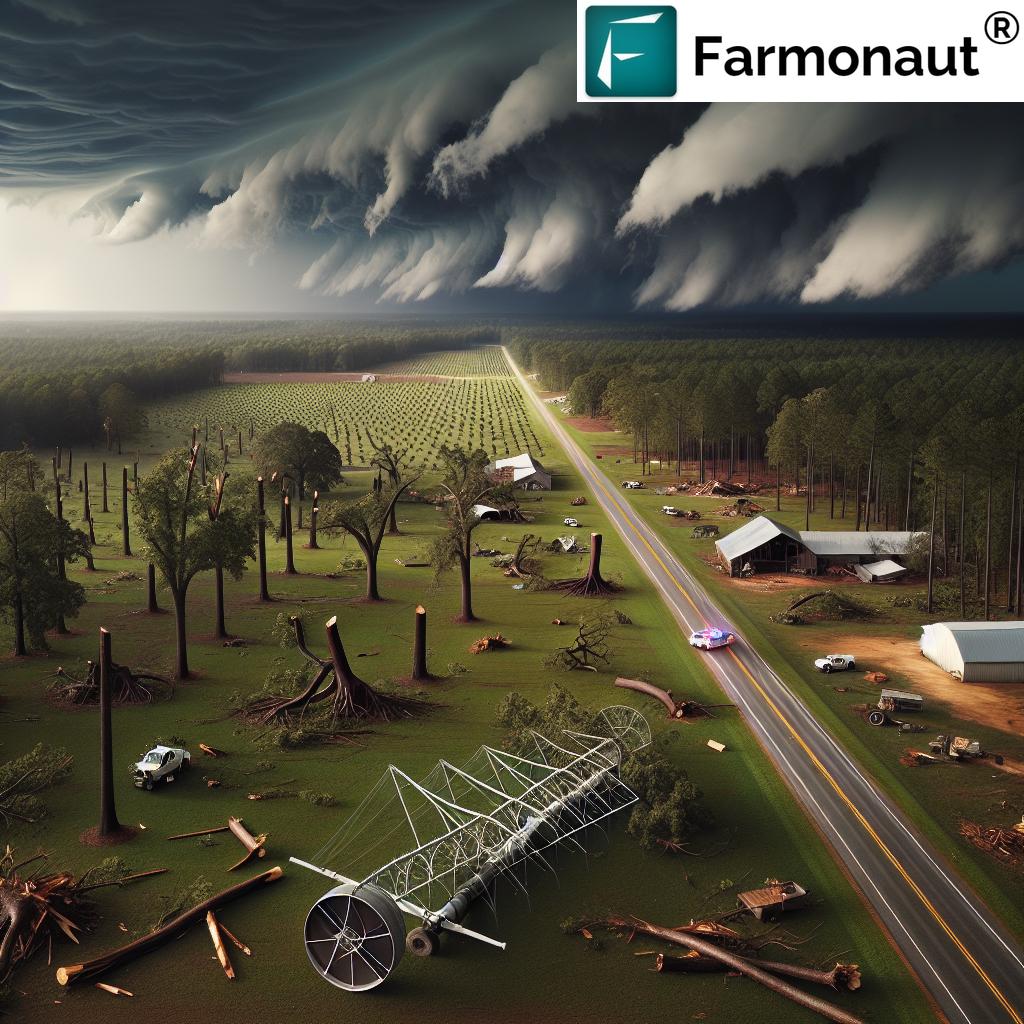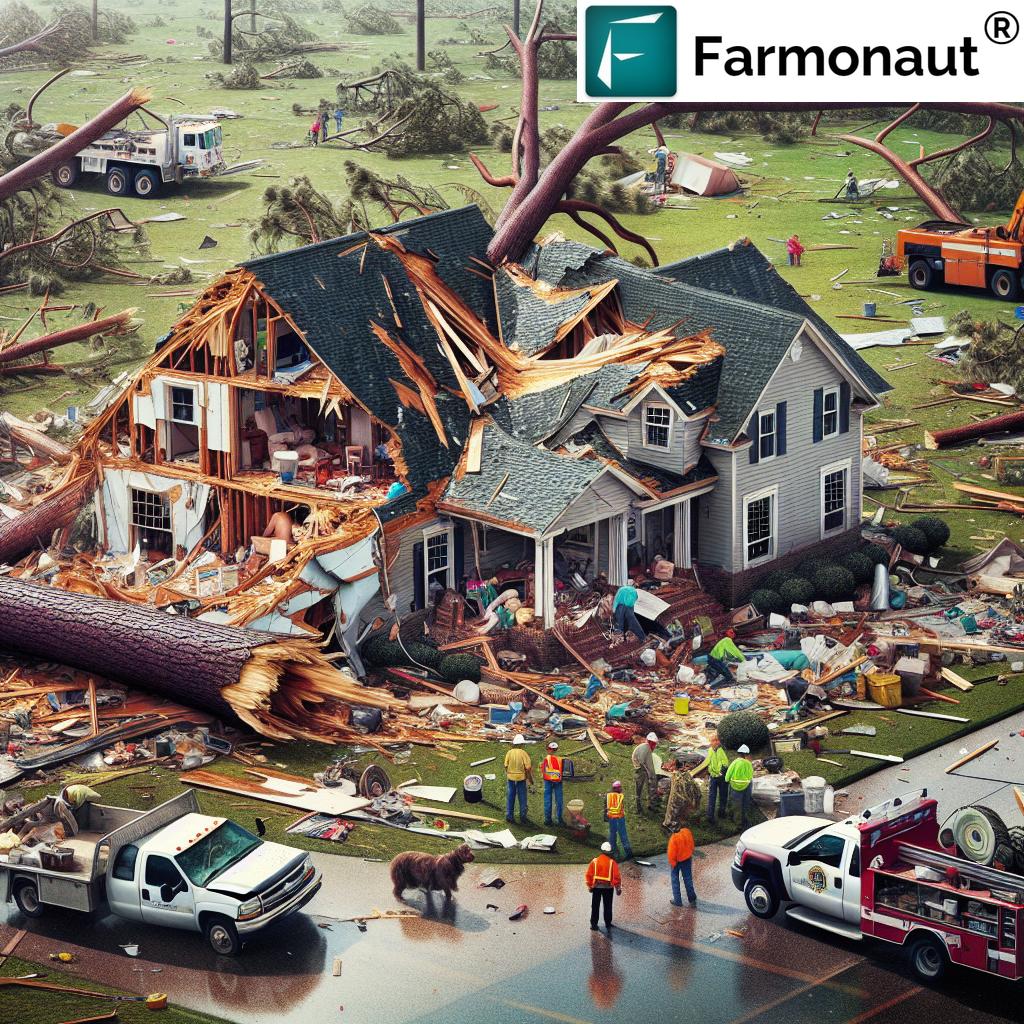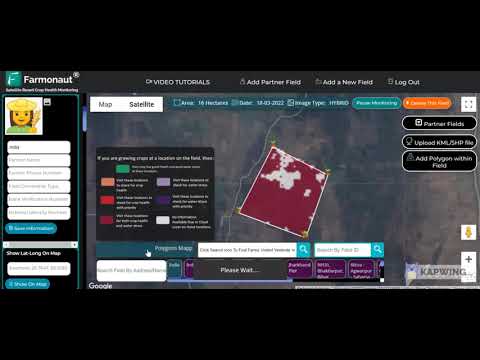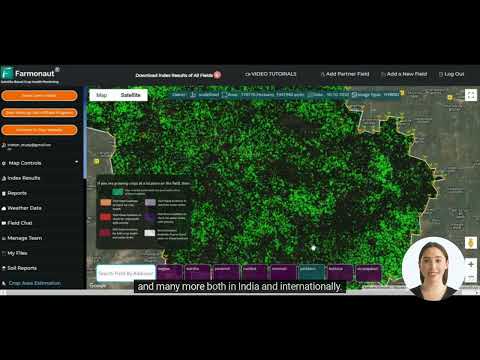Severe Weather Strikes Dooly County: Essential Guide to Agricultural and Residential Storm Damage Recovery
“Wind speeds reaching 53 mph in Dooly County uprooted trees and overturned irrigation systems during severe weather.”
In the wake of the recent severe weather that struck Dooly County and other parts of South Georgia, we find ourselves facing a challenging recovery process. As representatives of Farmonaut, we understand the critical role that accurate information and advanced agricultural technology play in times like these. Our mission to make precision agriculture accessible becomes even more crucial as we work together to rebuild and recover from this unexpected natural disaster.
In this comprehensive guide, we’ll walk you through the essential steps for agricultural and residential storm damage recovery, providing crucial information on cleanup efforts, damage reporting procedures, and available resources. We’ll also explore how innovative solutions, like those offered by Farmonaut, can aid in the assessment and recovery process.
The Scope of Severe Weather Damage in South Georgia
The severe weather event that rolled through South Georgia early Sunday morning left a trail of destruction in its wake, with Dooly County bearing a significant brunt of the impact. Wind speeds reaching a staggering 53 miles per hour caused widespread damage to both agricultural and residential properties.
- Agricultural structures and equipment suffered extensive damage
- At least three residential structures were damaged by fallen trees and high winds
- Numerous carports, barns, and standalone garages were damaged or destroyed
- Irrigation pivots were overturned throughout the county
- Valuable pecan orchards and pine trees were uprooted
- Campers were damaged and overturned
Fortunately, no injuries were reported as a result of the storm. However, the economic impact on the agricultural community and homeowners is significant and will require a coordinated effort to recover.

Immediate Response and Clean-up Efforts
In the aftermath of the storm, local emergency management and county departments swiftly mobilized to address the immediate needs of the community. The Dooly County Sheriff’s Office, Dooly County Road Department, and the Dooly County Fire Department worked tirelessly throughout Sunday morning to clear roads and assess the extent of the damage.
As of now, all roads in Dooly County are open and passable, which is crucial for the ongoing recovery efforts. However, residents and farmers are urged to remain cautious and report any additional damage or hazards they may encounter.
Steps for Storm Damage Recovery
If you’ve been affected by the severe weather in Dooly County or surrounding areas, here are the essential steps you should take for storm damage recovery:
- Ensure Safety: Before assessing any damage, ensure that it’s safe to do so. Be wary of downed power lines, unstable structures, and other potential hazards.
- Document the Damage: Take photographs and videos of all damage to your property, including structures, equipment, and crops. This documentation will be crucial for insurance claims and potential disaster assistance.
- Contact Your Insurance Company: Reach out to your insurance provider as soon as possible to initiate the claims process. Be prepared to provide detailed information about the damage.
- Report the Damage: Contact the Dooly County EMA Director, Don Williford, at (229) 947-0705 to report any storm damage. This helps local authorities assess the full scope of the impact and coordinate resources effectively.
- Secure Your Property: Take temporary measures to prevent further damage to your property, such as covering broken windows or damaged roofs with tarps.
- Seek Professional Assessment: For agricultural damage, consider consulting with local agricultural extension services or professional arborists to assess the long-term impact on crops and orchards.
At Farmonaut, we understand the importance of timely and accurate assessment in the wake of such disasters. Our satellite-based farm management solutions can provide valuable insights into crop health and damage extent, aiding in the recovery process.
Agricultural Impact and Recovery Strategies
The agricultural sector in Dooly County has been particularly hard hit by this severe weather event. Pecan orchards, a vital part of the local economy, have suffered significant damage with many trees uprooted. Additionally, the overturning of irrigation systems poses a serious challenge to farmers already preparing for the upcoming growing season.
Here are some strategies for agricultural recovery:
- Assess Crop Damage: Utilize advanced technologies like Farmonaut’s satellite-based crop health monitoring to get a comprehensive view of the damage to your fields.
- Prioritize Repairs: Focus on repairing critical infrastructure like irrigation systems to ensure you can maintain crop health moving forward.
- Consult Experts: Reach out to local agricultural extension services for advice on replanting strategies and soil management post-storm.
- Consider Crop Insurance: If you have crop insurance, contact your provider to understand your coverage and begin the claims process.
- Plan for the Future: Use this experience to develop more robust disaster preparedness plans for your farm, including the use of technologies that can help you monitor and respond to weather-related risks.
“Severe weather in South Georgia damaged homes, barns, and farming equipment, prompting swift response from local emergency management.”
Residential Property Damage and Recovery
For homeowners affected by the storm, the recovery process can be equally challenging. Here are some steps to take if your residential property has been damaged:
- Safety First: Ensure your home is safe to enter. If you have any doubts, have it inspected by a professional before re-entering.
- Document Everything: Take detailed photos and videos of all damage, both interior and exterior.
- Contact Your Insurance Company: Start the claims process as soon as possible. Provide all documentation and be prepared for an adjuster to visit your property.
- Prevent Further Damage: Make temporary repairs to prevent additional damage, but keep all receipts for materials used.
- Find Temporary Housing: If your home is uninhabitable, work with your insurance company to find temporary accommodations.
- Hire Reputable Contractors: For repairs, use licensed and insured contractors. Be wary of storm-chasing scammers who may try to take advantage of the situation.

The Role of Technology in Storm Damage Assessment and Recovery
In today’s digital age, technology plays a crucial role in disaster response and recovery. At Farmonaut, we leverage advanced satellite imagery and AI-driven analytics to provide farmers with invaluable insights into their land and crops. Here’s how technology can aid in the recovery process:
- Satellite Imagery: High-resolution satellite images can provide a bird’s-eye view of damage extent, helping prioritize recovery efforts.
- Crop Health Monitoring: Advanced vegetation indices like NDVI (Normalized Difference Vegetation Index) can help assess the impact on crop health post-storm.
- Weather Forecasting: Accurate, localized weather forecasts can help farmers and residents prepare for any additional weather events during the recovery period.
- Data-Driven Decision Making: By analyzing historical and current data, farmers can make informed decisions about replanting, soil management, and resource allocation.
To learn more about how Farmonaut’s technology can assist in your recovery efforts, visit our API Developer Docs or download our mobile apps:
Community Resources and Support
In times of crisis, community support is crucial. Here are some resources available to Dooly County residents and farmers:
- Dooly County Emergency Management Agency: For immediate assistance and to report damage, contact (229) 947-0705.
- Georgia Department of Agriculture: Offers resources and support for farmers affected by natural disasters.
- University of Georgia Cooperative Extension: Provides expert advice on agricultural recovery and crop management post-disaster.
- FEMA: In case of a federal disaster declaration, FEMA may offer additional assistance to affected individuals and businesses.
- Local Food Banks and Charities: Can provide immediate food and supply assistance to those in need.
Long-Term Recovery and Preparedness
As we work through the immediate recovery phase, it’s important to look ahead and consider long-term strategies for resilience and preparedness. Here are some considerations:
- Review and Update Insurance Policies: Ensure your coverage is adequate for potential future events.
- Implement Structural Improvements: Consider ways to make your property more resilient to severe weather, such as reinforced roofing or storm shutters.
- Develop a Disaster Plan: Create a comprehensive plan for your family or farm that outlines steps to take before, during, and after a severe weather event.
- Invest in Technology: Utilize tools like Farmonaut’s satellite-based monitoring to stay informed about your property’s condition and potential risks.
- Community Engagement: Participate in local emergency preparedness initiatives and support community resilience efforts.
Storm Damage Assessment and Recovery Steps
| Damage Category | Recovery Actions |
|---|---|
| Agricultural Structures | 1) Contact insurance company 2) Document damage with photos 3) Consult local agricultural extension for rebuilding guidance |
| Residential Properties | 1) Ensure safety before entering 2) Document all damage thoroughly 3) Contact insurance and begin claims process |
| Pecan Orchards | 1) Assess tree damage 2) Remove fallen limbs 3) Consult arborist for long-term recovery plan |
| Irrigation Systems | 1) Document damage for insurance 2) Assess repair vs. replacement options 3) Prioritize repairs to maintain crop health |
Leveraging Farmonaut’s Technology for Recovery
At Farmonaut, we’re committed to supporting farmers and agricultural communities through challenging times. Our advanced satellite-based farm management solutions can be particularly valuable in the aftermath of severe weather events like the one that struck Dooly County.
Here’s how our technology can assist in the recovery process:
- Rapid Damage Assessment: Our satellite imagery can quickly provide a comprehensive view of affected areas, helping prioritize recovery efforts.
- Crop Health Monitoring: Using multispectral satellite images, we can assess the impact on crop health, allowing farmers to make informed decisions about replanting or mitigation strategies.
- Soil Moisture Analysis: Our technology can help monitor soil moisture levels, which is crucial for understanding the storm’s impact on field conditions and planning irrigation strategies.
- Historical Data Comparison: By comparing current satellite data with historical imagery, we can help quantify the extent of damage for insurance claims and long-term recovery planning.
- Precision Agriculture Insights: Our AI-driven analytics can provide tailored advice on resource management and crop care during the recovery period.
To learn more about how Farmonaut can support your recovery efforts, visit our API page or explore our mobile applications.
Financial Assistance and Insurance Claims
Navigating the financial aspects of recovery can be daunting. Here are some key points to remember:
- Document Everything: Keep detailed records of all damage and repair costs.
- Understand Your Coverage: Review your insurance policies carefully and ask your agent to explain any unclear terms.
- Be Prompt: File claims as soon as possible to avoid delays in processing.
- Consider Additional Assistance: Look into state and federal disaster assistance programs if available.
- Seek Professional Help: Consider consulting with a public adjuster or attorney if you face difficulties with your insurance claim.
Remember, accurate documentation is crucial for successful claims. Farmonaut’s satellite-based monitoring can provide valuable data to support your insurance claims, especially for agricultural losses.
Community Resilience and Support
In times of crisis, the strength of a community shines through. Here are ways Dooly County residents can support each other:
- Volunteer: Offer your time and skills to local recovery efforts.
- Donate: Contribute to local charities and relief funds supporting affected families.
- Check on Neighbors: Especially the elderly or those with special needs who may require additional assistance.
- Share Resources: If you have extra supplies or equipment, consider sharing with those in need.
- Spread Information: Share accurate, up-to-date information about recovery efforts and available resources.
By working together, we can build a more resilient community that’s better prepared for future challenges.
Environmental Considerations in Recovery
As we work to recover from the storm’s impact, it’s important to consider the environmental aspects of our efforts:
- Proper Debris Disposal: Ensure storm debris is disposed of correctly to minimize environmental impact.
- Soil Conservation: Be mindful of soil erosion risks in damaged areas and implement conservation measures where needed.
- Water Quality: Monitor local water sources for potential contamination from storm runoff.
- Wildlife Considerations: Be aware of displaced wildlife and contact local authorities if you encounter injured animals.
- Sustainable Rebuilding: Consider incorporating sustainable practices and materials in reconstruction efforts.
Farmonaut’s technology can assist in monitoring environmental factors such as soil health and vegetation cover, helping to guide sustainable recovery efforts.
Looking Ahead: Building a More Resilient Future
As we navigate the challenges of recovery, it’s important to look ahead and consider how we can build a more resilient community and agricultural sector. Here are some strategies to consider:
- Embrace Technology: Utilize advanced tools like Farmonaut’s satellite-based monitoring to stay informed about your land’s condition and potential risks.
- Diversify Crops: Consider diversifying your agricultural portfolio to spread risk and increase resilience to weather-related challenges.
- Implement Sustainable Practices: Adopt farming methods that promote soil health and water conservation, which can improve your land’s resilience to extreme weather events.
- Invest in Infrastructure: Consider upgrades to farm infrastructure, such as improved drainage systems or wind-resistant structures.
- Participate in Community Planning: Engage with local authorities in disaster preparedness and land use planning to ensure community-wide resilience.
By taking these steps, we can work towards a future where our community and agricultural sector are better prepared to face and recover from severe weather events.
Conclusion
The severe weather that struck Dooly County and surrounding areas of South Georgia has undoubtedly presented significant challenges to our community. However, through coordinated efforts, leveraging of technology, and community support, we can navigate this recovery process and emerge stronger.
Remember, recovery is a marathon, not a sprint. It’s crucial to pace yourself, seek help when needed, and stay informed about available resources and support. As we rebuild and recover, let’s also take this opportunity to prepare for the future, implementing strategies and technologies that will make our farms and communities more resilient in the face of future challenges.
At Farmonaut, we’re committed to supporting farmers and agricultural communities with our advanced satellite-based solutions. Whether you’re assessing damage, planning recovery efforts, or looking to build a more resilient operation for the future, our technology is here to help.
Together, we can turn this challenge into an opportunity for growth, innovation, and community strengthening. Stay strong, Dooly County – we’re in this together.
FAQ Section
Q: How can I report storm damage in Dooly County?
A: Contact the Dooly County EMA Director, Don Williford, at (229) 947-0705 to report any storm damage.
Q: What should I do first if my property has been damaged?
A: Ensure your safety first, then document the damage with photos and videos before contacting your insurance company.
Q: How can Farmonaut’s technology help in storm recovery?
A: Farmonaut’s satellite-based monitoring can provide rapid damage assessment, crop health monitoring, and valuable data for insurance claims and recovery planning.
Q: Are there any financial assistance programs available for farmers affected by the storm?
A: Check with the Georgia Department of Agriculture and USDA for potential disaster assistance programs. Also, promptly file claims with your crop insurance provider.
Q: How can I prepare my farm for future severe weather events?
A: Consider implementing structural improvements, developing a comprehensive disaster plan, and utilizing technologies like Farmonaut for ongoing monitoring and risk assessment.
Earn With Farmonaut: Affiliate Program
Earn 20% recurring commission with Farmonaut’s affiliate program by sharing your promo code and helping farmers save 10%. Onboard 10 Elite farmers monthly to earn a minimum of $148,000 annually—start now and grow your income!





















